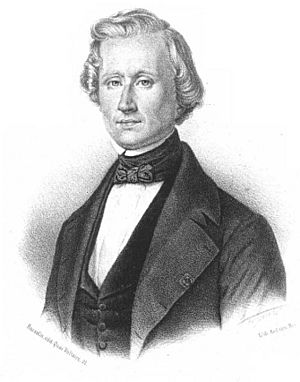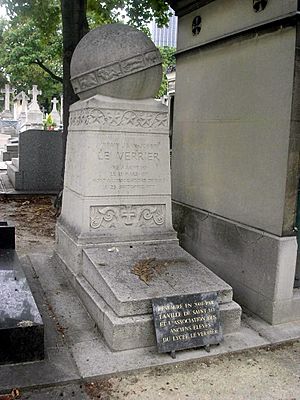Urbain Le Verrier facts for kids
Quick facts for kids
Urbain Le Verrier
|
|
|---|---|
 |
|
| Born |
Urbain Jean Joseph Le Verrier
11 March 1811 |
| Died | 23 September 1877 (aged 66) |
| Nationality | French |
| Alma mater | École Polytechnique |
| Known for | Discovery of Neptune Euler's three-body problem Faddeev–LeVerrier algorithm |
| Awards | Copley Medal (1846) Gold Medal of the Royal Astronomical_Society (1868, 1876) |
| Scientific career | |
| Fields | Mathematics, astronomy |
| Signature | |
 |
|
Urbain Jean Joseph Le Verrier (born March 11, 1811 – died September 23, 1877) was a French astronomer and mathematician. He was an expert in celestial mechanics, which is the study of how planets and other space objects move.
Le Verrier is most famous for predicting the existence and exact location of the planet Neptune. He did this using only math! He noticed that the planet Uranus wasn't moving exactly as it should according to the laws of Kepler and Newton. Le Verrier figured out that another, unseen planet must be pulling on Uranus. He sent his calculations to another astronomer, Johann Gottfried Galle, in Berlin. Galle found Neptune that very night, almost exactly where Le Verrier said it would be. This discovery was a huge success for science in the 1800s.
Contents
Biography
Early Life and Studies
Urbain Le Verrier was born in Saint-Lô, France. His family was not rich, but they were well-respected. He went to a famous school called École Polytechnique.
At first, he studied chemistry. He even wrote papers about how different chemicals combine. But soon, he became very interested in astronomy, especially how planets move. He got a job at the Paris Observatory, which is a place where scientists study the stars and planets. He spent most of his career there. He even became the Director of the Observatory twice, from 1854 to 1870 and again from 1873 to 1877.
In 1846, Le Verrier became a member of the French Academy of Sciences. This is a very important group of scientists in France. His name is also one of the 72 names written on the Eiffel Tower in Paris.
Career Highlights
Early Astronomy Work
Le Verrier's first big astronomy project was in 1839. He studied how the orbits of planets change over very long periods. This was important because scientists wanted to know if our Solar System was stable, meaning if the planets would keep orbiting safely. He made some important discoveries, but he needed more accurate information about the planets' masses.
From 1844 to 1847, Le Verrier also studied comets. He showed that some comets that seemed new were actually old ones that had been pushed into different paths by planets like Jupiter.
The Discovery of Neptune
Le Verrier's most famous achievement was predicting the existence of Neptune. The Director of the Paris Observatory, François Arago, encouraged him to work on this. Le Verrier spent months doing very complex math. He was trying to figure out why Uranus wasn't following its predicted path around the Sun. It seemed like something unseen was pulling on it.
Another astronomer in England, John Couch Adams, was doing similar calculations at the same time. But Le Verrier was the first to publicly announce his prediction. On August 31, 1846, he told the French Academy where he thought the new planet would be.
On September 18, Le Verrier sent his prediction to Johann Gottfried Galle at the Berlin Observatory. Just five days later, on September 23, 1846, Galle and his student Heinrich Louis d'Arrest found the planet! It was almost exactly where Le Verrier said it would be. This was an amazing moment in science, showing the power of mathematics.
There was some discussion about who should get credit for the discovery. But it's clear that Le Verrier's calculations led directly to Neptune being found.
Mapping the Planets
In the early 1800s, predicting where planets would be was a bit messy. Many different scientists had developed different ways to do it. In 1847, Le Verrier decided to create a complete and accurate map of the entire Solar System. He wanted to make sure all the planet movements made sense together. If they didn't, he wanted to find out why.
This huge project took him the rest of his life. He gathered observations of planets going all the way back to 1750. He then published detailed tables showing the movements of all the known planets. These tables were used by astronomers for many years to predict where planets would be in the sky.
The Mystery of Mercury's Orbit
Le Verrier also studied the planet Mercury. In 1859, he noticed something strange: Mercury's orbit around the Sun was slowly shifting, or "precessing," more than it should according to Newton's laws of gravity.
He thought that maybe another planet, even closer to the Sun than Mercury, was causing this extra pull. This idea was exciting because it was how Neptune was found! Scientists even gave this possible new planet a name: Vulcan. However, no such planet was ever found. The mystery of Mercury's orbit was finally solved much later by Albert Einstein's general relativity theory, which showed that gravity works a bit differently than Newton thought, especially near very massive objects like the Sun.
Later Life
Le Verrier was a brilliant scientist, but he was not always easy to work with. He had some disagreements with the staff at the Paris Observatory. He was even removed from his position as Director in 1870. But he was put back in charge in 1873 and stayed there until he died in 1877.
Le Verrier was married and had three children. He died in Paris and is buried in the Montparnasse Cemetery. A large stone globe sits on top of his grave. People remember him by a famous saying from François Arago: "the man who discovered a planet with the point of his pen."
Honours
- Gold Medal of the Royal Astronomical Society – He won this important award twice, in 1868 and 1876.
- Craters on the Moon and Mars are named after him.
- One of the rings of Neptune is named Le Verrier.
- An asteroid is named 1997 Leverrier.
- His name is on the Eiffel Tower.
See also
 In Spanish: Urbain Le Verrier para niños
In Spanish: Urbain Le Verrier para niños
- Discovery of Neptune
- List of works by Henri Chapu Statue of Le Verrier




